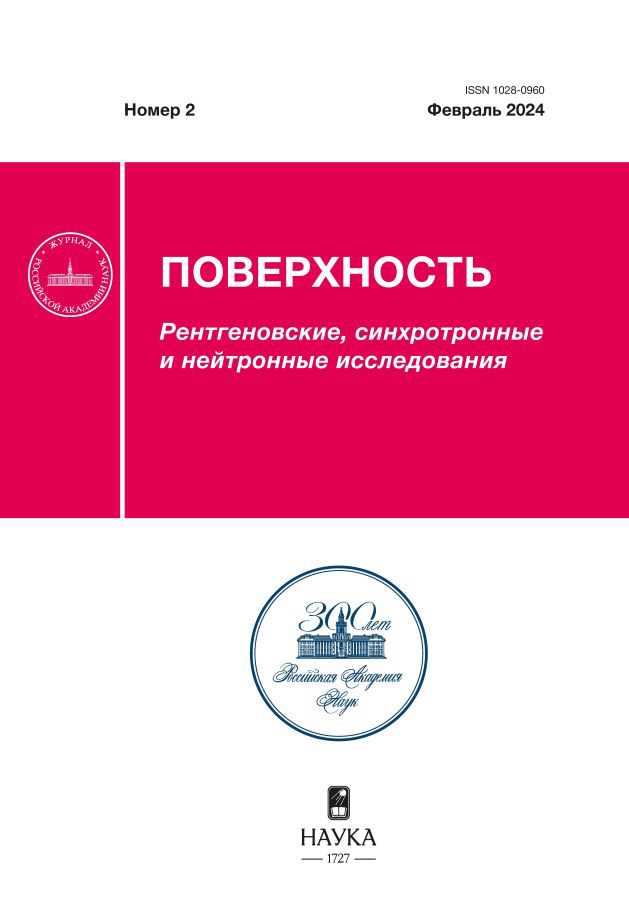Temperature Effect on the Interlayer Exchange Interaction in a Co/Pd/Co Heterostructure
- Авторлар: Shashkov I.V.1,2, Kabanov Y.P.1, Evstigneev R.S.1, Gornakov V.S.1
-
Мекемелер:
- Osipyan Institute of Solid State Physics of the RAS
- MIREA – Russian University of Technology
- Шығарылым: № 2 (2024)
- Беттер: 54-59
- Бөлім: Articles
- URL: https://freezetech.ru/1028-0960/article/view/664778
- DOI: https://doi.org/10.31857/S1028096024020089
- EDN: https://elibrary.ru/BAIGJB
- ID: 664778
Дәйексөз келтіру
Аннотация
Using Kerr microscopy, the magnetization reversal of the Co(0.4 nm)/Pd(6 nm)/Co(0.4 nm) heterostructure was studied in the temperature range 15–300 K. The temperature dependence of the domain nucleation field in a sample magnetized to saturation was obtained. The nucleation field in both ferromagnetic layers was shown to decrease monotonically with increasing temperature. A region of unstable temperatures of 160–174 K was found, below which the through domains of the new phase nucleated simultaneously in both layers, while in this region domains also nucleated simultaneously in different layers, but in different sites of the sample. The temperature dependence of the effective field HJ of the interlayer exchange interaction was obtained, which increased or decreased the pressure on the domain wall depending on whether this field was added to or subtracted from the external field.
Толық мәтін
Авторлар туралы
I. Shashkov
Osipyan Institute of Solid State Physics of the RAS; MIREA – Russian University of Technology
Хат алмасуға жауапты Автор.
Email: shav@issp.ac.ru
Ресей, Chernogolovka; Moscow
Yu. Kabanov
Osipyan Institute of Solid State Physics of the RAS
Email: shav@issp.ac.ru
Ресей, Chernogolovka
R. Evstigneev
Osipyan Institute of Solid State Physics of the RAS
Email: shav@issp.ac.ru
Ресей, Chernogolovka
V. Gornakov
Osipyan Institute of Solid State Physics of the RAS
Email: shav@issp.ac.ru
Ресей, Chernogolovka
Әдебиет тізімі
- Parkin S., Yang S.H. // Nature Nanotechnol. V. 10. № 3. P. 195. https://doi.org./10.1038/nnano.2015.41
- Omelchenko P., Montoya E., Girt E., Heinrich B. // J. Exp. Theor. Phys. 2020. V. 131. № 1. P. 113. https://doi.org./10.1134/S1063776120070080
- Lu B., Klemmer T.,Wierman K., Ju G.P., Weller D., Roy A.G., Laughlin D.E., Chang C.H., Ranjan R. // J. Appl. Phys. 2002. V. 91. № 10. P. 8025. https://doi.org./10.1063/1.1452269
- Moritz J., Garcia F., Toussaint J.C., Dieny B., Nozières J.P. // Europhys. Lett. 2004. V. 65. № 1. P. 123. https://doi.org./10.1209/epl/i2003-10063-9
- Lim W.L., Ebrahim-Zadeh N., Owens J.C., Hentschel H.G.E., Urazhdin S. // Appl. Phys. Lett. 2013. V. 102. P. 162404. https://doi.org./10.1063/1.4802954
- Grolier V., Renard D., Bartenlian B., Beauvillain P., Chappert C., Dupas C., Ferré J., Galtier M., Kolb E., Mulloy M., Renard J.P., Veillet P. // Phys. Rev. Lett. 1993. V. 71. P. 3023. https://doi.org./10.1103/PhysRevLett.71.3023
- Shull R.D., Iunin Y.L., Kabanov Y.P., Nikitenko V.I, Skryabina O.V., Chien C.L. // J. Appl. Phys. 2013. V. 113. № 17. P. 17C101. https://doi.org./10.1063/1.4793703
- Шашков И.В., Горнаков В.С., Кабанов Ю.П. // Поверхность. рентген., синхротр. и нейтрон. исслед. 2021. № 11. С. 80. https://doi.org./10.31857/S1028096021110182
- Xie X.P., Zhao X.W., Knepper J.W., Yang F.Y., Sooryakumar R. // Phys. Rev. B. 2007. V. 76. P. 184433. https://doi.org./10.1103/PhysRevB.76.184433
- Lemerle S., Ferre J., Chappert C., Mathet V., Giamarchi T., Le Doussal P. // Phys. Rev. Lett. 1998. V. 80. P. 849. https://doi.org./10.1103/PhysRevLett.80.849
- Chauve P., Giamarchi T., Le Doussal P. // Phys. Rev. B. 2000. V. 62. P. 6241. https://doi.org./10.1103/PhysRevB.62.6241
- Metaxas P.J., Jamet J.P., Mougin A., Cormier M., Ferré J., Baltz V., Rodmacq B., Dieny B., Stamps R.L. // Phys. Rev. Lett. 2007. V. 99. P. 217208. https://doi.org./10.1103/PhysRevLett.99.217208
- Jeudy V., Mougin A., Bustingorry S., Savero Torres W., Gorchon J., Kolton A. B., Lemaître A., Jamet J.P. // Phys. Rev. Lett. 2016. V. 117. 057201. https://doi.org./10.1103/PhysRevLett.117.057201
- Quinteros C.P., Bustingorry S., Curiale J., Granada M. // Appl. Phys. Lett. 2018. V. 112. P. 262402. https://doi.org./10.1063/1.5026702
- Kim D.Y., Park M.H., Park Y.K., Yu J.S., Kim J.S., Kim D.H., Min B.C., Choe S.B. // Appl. Phys. Lett. 2018. V. 112. P. 062406. https://doi.org./10.1063/1.5009726
- Gorchon J., Bustingorry S., Ferré J., Jeudy V., Kolton A.B., Giamarchi T. // Phys. Rev. Lett. 2014. V. 113. P. 027205. https://doi.org./10.1103/PhysRevLett.113.027205
- Metaxas P.J., Jamet J.P., Ferré J., Rodmacq B., Dieny B., Stamps R.L. // J. Magn. Magn. Mater. 2008. V. 320. № 21. P. 2571. https://doi.org./10.1016/j.jmmm.2008.03.041
- Ferré J., Metaxas P.J., Mougin A., Jamet J.P., Gorchon J., Jeudy V. // Compt. Rend. Phys. 2013. V. 14. P. 651. https://doi.org./10.1016/j.crhy.2013.08.001
- Shashkov I., Kabanov Y., Tikhomirov O., Gornakov V. // Magnetism. 2022. V. 2. № 2. P. 186. https://doi.org./10.3390/magnetism2020014
- Kim J., Kim K.J., Choe S.B., Kim J. // IEEE Trans. Magn. 2009. V. 45. P. 3909. https://doi.org./10.1109/TMAG.2009.2021410
- Diaz Pardo R., Savero Torres W., Kolton A.B., Bustingorry S., Jeudy V. // Phys. Rev. B. 2017. V. 95. P. 184434. https://doi.org./10.1103/PhysRevB.95.184434
Қосымша файлдар












